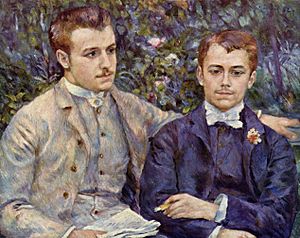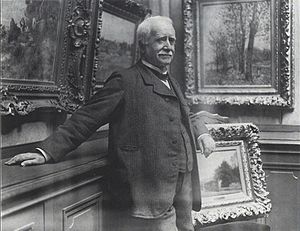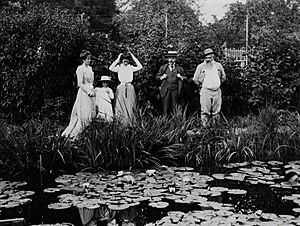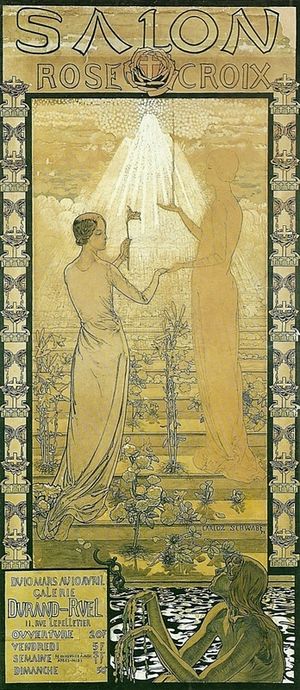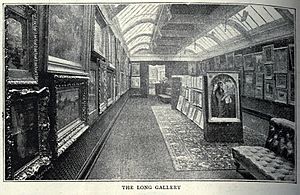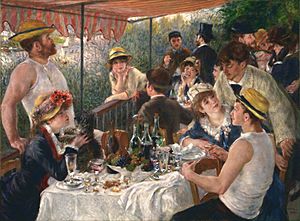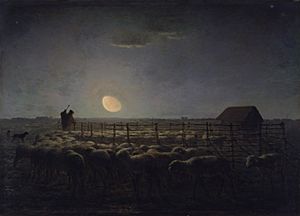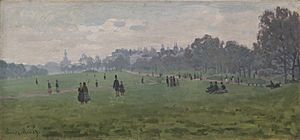Paul Durand-Ruel facts for kids
Quick facts for kids
Paul Durand-Ruel
|
|
|---|---|
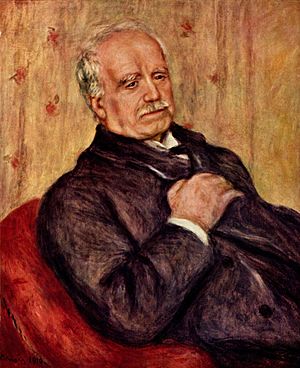
Portrait of Paul Durand-Ruel, Pierre-Auguste Renoir c. 1910
|
|
| Born | 31 October 1831 Paris, France
|
| Died | 5 February 1922 (aged 90) |
| Nationality | French |
| Known for | Art Dealing, Impressionist Movement, Modern Art Markets |
Paul Durand-Ruel (born October 31, 1831, died February 5, 1922) was a French art dealer. He is famous for supporting the Impressionists and the Barbizon School artists. He was one of the first to believe in artists like Claude Monet, Camille Pissarro, and Pierre-Auguste Renoir.
Paul Durand-Ruel changed how art was sold and bought. Many people think he was the most important art dealer of the 1800s. He was a very driven businessman. He helped French artists become famous around the world. He did this by opening art galleries and holding exhibitions in cities like London, New York, and Berlin. He also helped break the old system where only the Salon in France decided which art was important.
Contents
Early Life and Family
Paul-Marie-Joseph Durand-Ruel was born in Paris. His parents, Jean Marie Fortuné Durand and Marie Ferdinande Ruel, opened an art shop in 1839. They named their family business Durand-Ruel.
In 1851, Paul started at a military school called Ecole Militaire de Saint-Cyr. But he had to leave soon after because of his health. Paul Durand-Ruel married Jeanne Marie Eva Lafon in 1862. Their first child was born not long after.
Career as an Art Dealer
In 1865, Paul took over the family art business. At first, the gallery showed artists like Jean-Baptiste-Camille Corot and painters from the Barbizon School. These artists were known for their French landscape paintings.
In the 1860s and early 1870s, Durand-Ruel was a strong supporter of the Barbizon School. But he is best known for his work with the group of painters called the Impressionists.
Paul had three sons who worked with him: Joseph (1862-1928), Charles (1865-1892), and Georges (1866-1931). After 1888, his sons started to take over the business. They helped expand into the American art market. They bought works by artists like Eugène Delacroix and the Barbizon School painters. Later, they focused on the Impressionists.
The brothers also held exhibitions for other artists. These included Odilon Redon in 1894, Pierre Bonnard in 1896, and Paul Gauguin in 1903. By 1911, Joseph and Georges were fully in charge. They specialized in Impressionist art. Joseph's son, also named Charles, later managed the Paris branch of the family business.
The Salon System and New Art Markets
Before the 1900s, the French 'Salon System' was the main way to show art to the public. The Salon was good for funding new artists. But it was controlled by the government and the French Academy. This made it hard for artists to get noticed if they weren't approved.
The Impressionists were a group of artists who were often not accepted by the Salon. They were the first to successfully hold their own art shows outside of the government system. Paul Durand-Ruel and other art dealers helped them.
These new exhibitions worked differently. Artists kept the money from their own sales. The success of a show depended on whether people wanted to buy the art. It did not depend on what the government or critics thought. This new way of working, with art dealers and independent shows, started in the 1870s. It broke the Salon's power and began a new era for art markets.
Supporting La Belle École
Before he supported the Impressionists, Durand-Ruel worked to increase the value of art from 'the beautiful School of 1830'. This group of artists was known for their Romanticism and landscape painting. Important artists in this group included Jean-Baptiste-Camille Corot, Théodore Rousseau, Jean-François Millet, Eugène Delacroix, and Gustave Courbet.
Durand-Ruel actively collected paintings from these artists in the 1860s and 70s. By 1874, he owned 432 works by Delacroix, Corot, and Rousseau. This put him in a difficult financial situation. During this time, he developed seven new ideas for supporting art and making its value grow. He organized international exhibitions and created public interest in his art. His investment in La Belle École became very profitable. This success helped him later support the Impressionist artists.
Championing Impressionism
Paul Durand-Ruel saw the artistic value of Impressionism early on, around 1870. His first big exhibition of their work was in his London gallery in 1872. He held shows of Impressionist art in his galleries in Paris and London.
For the last 30 years of the 1800s, Durand-Ruel was the most important person selling French Impressionist art worldwide. He successfully created a market for Impressionism in both the United States and Europe. He helped many important Impressionist artists become famous. These included Edgar Degas, Mary Cassatt, Édouard Manet, Claude Monet, Berthe Morisot, Camille Pissarro, Pierre-Auguste Renoir, and Alfred Sisley.
Impressionism became successful partly because people around the world wanted it. Durand-Ruel created a network of galleries and exhibitions in many countries. His main centers were in London, New York, and Berlin. He once said about Americans buying Impressionist art: "The American public does not laugh. It buys!" He also said that without America, he would have been ruined after buying so many Monets and Renoirs. The exhibitions there in 1886 saved him.
Expanding to London
During the Franco-Prussian War (1870–71), Durand-Ruel left Paris and went to London. There, he met other French artists who were also in exile. These included Charles-François Daubigny, Claude Monet, and Camille Pissarro.
In December 1870, he opened his first London gallery. It was at 168 New Bond Street. He held ten yearly exhibitions there, called the "Annual Exhibitions of the Society of French Artists."
In London, Durand-Ruel tried new ways to show art. He provided a catalog for each show and charged an entrance fee. He also placed unknown works next to famous, high-priced art to make them seem more valuable. During this time, he bought important paintings like Jacques-Louis David's Marat and Delacroix's Death of Sardanapalus. He showed these to get more attention.
He also started to show paintings by the then-unknown Monet and Pissarro. From 1872, he began buying many Impressionist paintings. Durand-Ruel held London's first shows focused only on Impressionist art in 1882 and 1883. These shows were not successful and almost caused him to go bankrupt.
In 1905, Durand-Ruel returned to London for a huge exhibition of Impressionist paintings. Most of these came from his own collection. The show at The Grafton Galleries had 315 paintings by artists like Manet, Pissarro, Renoir, and Monet. Even though he only sold 13 paintings directly, the show made international art collectors interested in Impressionism.
Success in the United States
Durand-Ruel started working with American art collectors in the 1860s. At first, these were short projects, like exhibitions in Boston and Philadelphia. He also met clients in Paris.
In 1887, Durand-Ruel opened his first permanent gallery in the United States. This New York City gallery was very important for his success with Impressionism. His American business was officially called Durand-Ruel & Sons. By 1893, his sons Joseph, Charles, and Georges were part of it.
With his sons' help, Durand-Ruel had a lasting presence in the United States. Besides the New York City gallery, he organized exhibitions in many other cities. These included Boston, Philadelphia, and Chicago. The family-run American business continued even after Paul Durand-Ruel died, until 1950.
Expanding to Germany
Durand-Ruel's business in Germany grew after his success in the United States. Germany had its first exhibition of Impressionists in 1883, with Durand-Ruel's help.
In the 1880s, Paul Durand-Ruel focused mostly on the United States. His presence in Germany was helped by the German art critic Emil Heilbut. Heilbut bought and sold many paintings between 1880 and 1896. Durand-Ruel's connection with German painter Max Liebermann led to exhibitions in Dresden, Berlin, and Hamburg. These shows featured both French Impressionism and Liebermann's own work.
From 1899, Durand-Ruel's business in Germany was mainly in Berlin. He worked with German art dealer Paul Cassirer, who had a permanent art gallery there.
New Ideas for Art Markets
Durand-Ruel had seven new ideas for how art markets should work:
- Protect and support art above everything else.
- Work only with specific artists for their art.
- Hold individual exhibitions for artists.
- Create a network of galleries around the world.
- Allow people to visit his galleries and home freely.
- Use the news and press to promote artists' work.
- Connect the art world with the financial world.
With these ideas, Durand-Ruel changed art markets. Artists could now be supported financially by people who believed in their work. Between 1891 and 1922, Durand-Ruel bought almost 12,000 paintings. In 1920, at 89 years old, he said: "Finally the Impressionist masters won, just like the artists of 1830. My crazy ideas had been wise. To think that if I had died at sixty, I would have died in debt and bankrupt, surrounded by many treasures that no one appreciated…"
Artists He Supported
| Name | Lifespan | Movement | # of Works linked to Paul Durand-Ruel |
|---|---|---|---|
| ANDRE, Albert | 1869-1954 | Post-Impressionism | |
| BARYE, Antoine-Louis | 1795-1895 | Sculptor | |
| BENASSIT, Émile | 1833-1902 | Genre | |
| BOUDIN, Eugène | 1824-1898 | Impressionism | ~400 |
| BROWN, John-Lewis | 1829-1890 | Genre | |
| CAILLEBOTTE, Gustave | 1848-1894 | Realism, Impressionism | |
| CASSATT, Mary | 1844-1926 | Impressionism | ~400 |
| CEZANNE, Paul | 1839-1906 | Impressionism | |
| COROT, Jean-Baptiste | 1796-1875 | Realism | ~300 |
| COURBET, Gustave | 1819-1877 | Realism | >30 |
| DAUBIGNY, Charles-François | 1817-1878 | Realism | |
| DAUMIER, Honoré | 1808-1879 | Realism, Impressionism | |
| DEGAS, Edgar | 1834-1917 | Impressionism | ~400 |
| DELACROIX, Eugène | 1798-1863 | Romanticism | ~200 |
| DIAZ DE LA PENA, Narcisse-Virgile | 1807-1876 | Orientalism | |
| DURENNE, Eugène-Antoine | 1860-1944 | Impressionism | |
| EDZARD, Dietz | 1893-1963 | Impressionism | |
| ESPAGNAT, Georges d' | 1870-1950 | Post-Impressionism | |
| FANTIN-LATOUR, Henri Théodore Jean Ignace | 1836-1904 | Impressionism | |
| FORAIN, Jean-Louis | 1852-1931 | Impressionism | |
| GAUGUIN, Paul | 1848-1903 | Impressionism | |
| GUILLAUMIN, Jean-Baptiste-Armand | 1841-1927 | Impressionism | |
| HASSAM, Childe | 1859-1935 | Impressionism | |
| HELLEU, Paul-César | 1859-1927 | Post-Impressionism | |
| HOSCHEDE-MONET, Blanche | 1865-1947 | Impressionism | |
| HUGUET, Victor-Pierre | 1835-1902 | Orientalism | |
| JONGKIND, Johan ou Jean-Barthold | 1819-1891 | Impressionism | |
| KHMELUK, Vassyl | 1903-1986 | Post-Impressionism | |
| LEPINE, Stanislas-Victor-Edouard | 1835-1892 | Impressionism | |
| LOISEAU, Gustave | 1865-1935 | Post-Impressionism | |
| MANET, Edouard | 1832-1883 | Realism, Impressionism | ~200 |
| MAUFRA, Maxime, Maxime-Emile-Louis | 1861-1918 | Impressionism | |
| MILLET, Jean François | 1814-1875 | Realism | >61 |
| MONET, Claude | 1840-1926 | Impressionism | ~1,000 |
| MORET, Henry | 1856-1913 | Impressionism | |
| MORISOT, Berthe | 1841-1895 | Impressionism | |
| PISSARRO, Camille | 1830-1903 | Impressionism | ~800 |
| PUVIS DE CHAVANNES, Pierre | 1824-1898 | Symbolism | |
| REDON, Odilon | 1840-1916 | Post-Impressionism | |
| RENOIR, Pierre-Auguste | 1841-1919 | Impressionism | ~1,500 |
| RODIN, August | 1840-1917 | Sculptor | |
| ROUSSEAU, Théodore | 1812-1867 | Realism, Romanticism | ~100 |
| SISLEY, Alfred | 1839-1899 | Impressionism | ~400 |
| TOULOUSE-LAUTREC, Henri de | 1864-1901 | Post-Impressionism | |
| VALTAT, Louis | 1869-1952 | Fauvism | |
| VIGNON, Victor-Alfred-Paul | 1847-1909 | Impressionism | |
| ZANDOMENEGHI, Federico | 1841-1917 | Impressionism | |
| ZIEM, Félix-François-Georges-Philibert | 1821-1911 | Orientalism |
Legacy and Impact
Paul Durand-Ruel helped bring art to a free market system. But he also believed that art itself was the most important thing. He looked for the most real and true art. He invested in artists he thought had great talent. This made him a pioneer in what it means to be a modern art dealer.
Both Paul Durand-Ruel and his father tried to keep their personal political views separate from the art they supported. Even though they were conservative, they invested in the progressive École de 1830. Because of his approach to art dealing, Durand-Ruel is seen as the first dealer to truly appreciate Impressionist art.
In 2015, a big exhibition called "Inventing Impressionism" was held at the National Gallery in London. It was all about Paul Durand-Ruel and his work.
See also
 In Spanish: Paul Durand-Ruel para niños
In Spanish: Paul Durand-Ruel para niños


